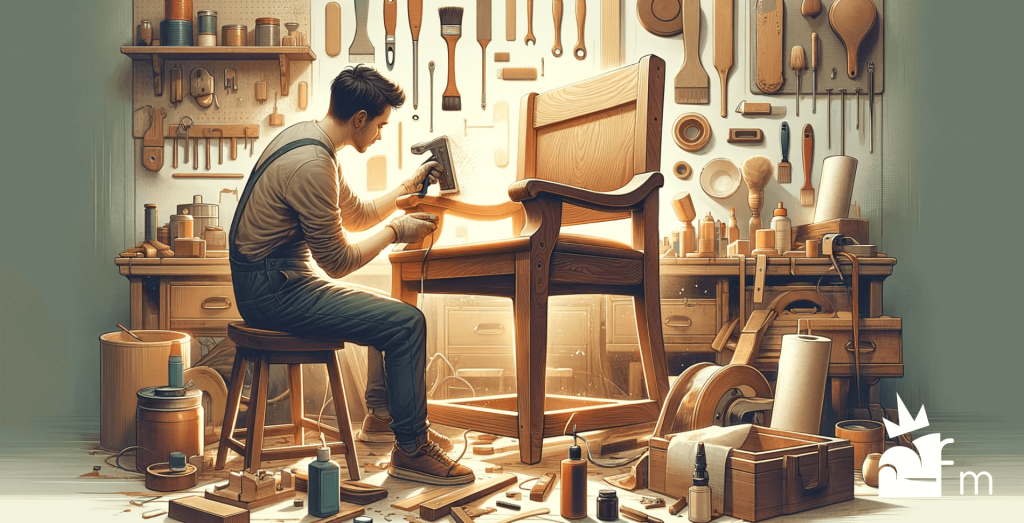We can’t argue on how good this wood is for other appliances like cardboard cabinets and flooring. It’s flexible and works perfectly on different types of woodwork. Still, chipped wood was never the best option for furniture.
We’ve all been there, gazing in despair at a piece of beautiful wooden furniture corner that got ruined a bit in the corner. It feels like a little piece of your soul has chipped away with it, doesn’t it?
The worst is chipping, which is a common issue that often happens even with a slighted bit of force. But the best part is, that it’s also incredibly fixable. Whether it’s a cherished antique or a newer piece that you’re fond of, learning how to fix chipped wood is a skill that will save you both time and money.
In this guide, we will show you how to fix chipped wood. So, stick around as we delve into the nitty-gritty of patching up that wooden masterpiece.
- 11 Essential Supplies You Will Need to Repair Chipped Wood
- 5 Steps to Easily Repair Your Chipped Wood
- FAQ
11 Essential Supplies You Will Need to Repair Chipped Wood
Fixing chipped wood might become hard, tiresome work, and it might take hours for you to finish. It makes sense that you will face difficulties handling equipment, let alone searching for any.
Here is a list of things you will need to gather,
- Flat chisel
- Fine-grit sandpaper
- Wood glue
- Soft cloth
- Rubbing alcohol or acetone
- Clamps
- Disposable gloves
- Safety goggles
- Dust mask
- Paint scraper
- Small paint brush for glue application
5 Steps to Easily Repair Your Chipped Wood Furniture

Below, we will show you an easy fix with glue that will last long and protect your furniture for a long time.
Step 1: Identify the problem area
Inspect the area where the wood glue has chipped away thoroughly. Clean the surface with a soft cloth to remove any loose chips or debris. This initial cleaning ensures you have a clear understanding of wood damage, allowing you to prepare adequately for the repair process.
Step 2: Pre-treat the surface
Before diving into removing old glue or applying new one, it’s crucial to pre-treat the surface. You can do this by slightly moistening a cloth with rubbing alcohol or acetone and wiping the area. This will help in removing any residual oils or contaminants that could affect the new glue’s bonding capability.
Step 3: Remove old glue
Gently but firmly scrape away the damaged wood glue using a flat chisel. Be cautious in this step, as the aim is to remove the damaged glue without further harming the wood. Any leftover old glue can significantly compromise the quality of the new adhesive bond.
Step 4: Sand and clean
After successfully removing the old glue, take fine-grit sandpaper and sand the area until smooth. The purpose of this step is not just to even out the surface but also to prepare the wood for better glue adhesion. Post-sanding, make sure to clean the area again to eliminate any dust or wood particles.
Step 5: Reapply wood glue
Finally, spread an even layer of fresh wood glue across the sanded and cleaned area. Press the surfaces together firmly and adhere to the manufacturer’s guidelines regarding drying time for maximum effectiveness.
FAQ on How to Fix Chipped Wood
Is snapped wood repairable?
Yes, you can absolutely repair snapped wood. Using the right adhesive and clamping technique, you can restore both functionality and appearance. The key is proper preparation and patience.
How to fix scratches on wood?
Fixing scratches in wood is within your reach. Employ fine-grit sandpaper to smooth the area, followed by a matching stain and a final sealant coat to seamlessly blend the scratch away.
Is Fevicol a PVA glue?
Indeed, Fevicol is a form of PVA glue. It’s excellent for woodworking, offering a strong bond and water-resistant properties. It’s both user-friendly and widely available, making it a go-to choice.
Is wood filler good for chipped wood?
Wood filler is a suitable option for chipped wood when you’re concerned about aesthetics. However, for structural concerns, combining wood filler with other adhesives can provide a more robust fix.
Does wood glue last permanent?
Wood glue can offer a near-permanent bond if applied correctly. The longevity can be affected by environmental factors, so ensure you’re using the right glue for the wood type and conditions.
Our Verdict
You’ve just walked through the essential steps and considerations for fixing chipped wood, understanding the pivotal role of adhesives, the finesse required for sanding, and the choice of using fillers for aesthetic concerns. Repairing wood isn’t merely a DIY endeavor; it’s about preserving the quality and extending the lifespan of your valuable wooden items.
The skills and knowledge you’ve acquired are not only practical but also economical, saving you the cost of replacements in the long run. With the right tools, methods, and a bit of patience, you’re well-equipped to restore your chipped wood to its former glory.
Happy repairing!

